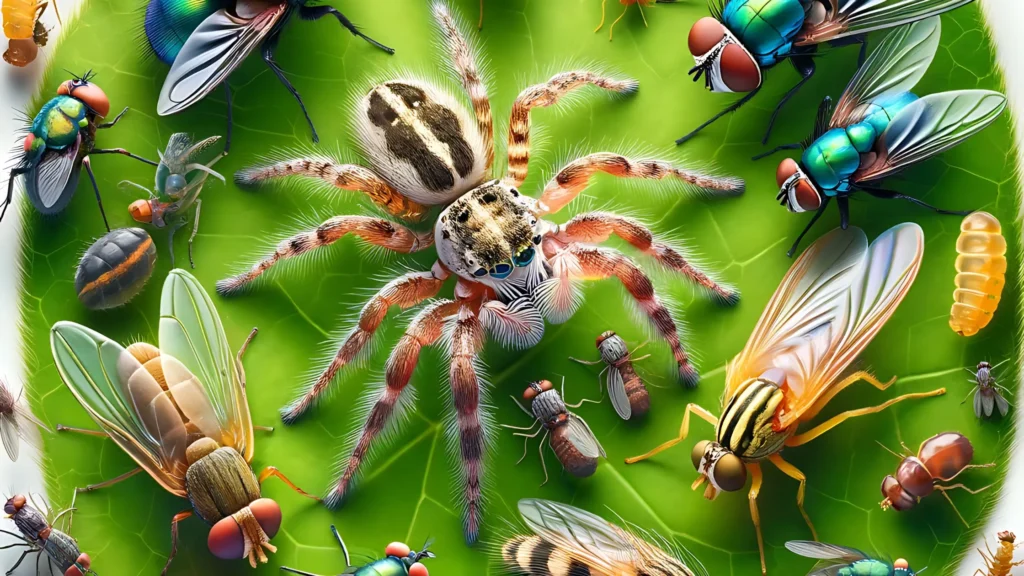
Explore Hunting Habits and Dietary Secrets of Jumping Spiders
Jumping spiders, members of the family Salticidae, are fascinating creatures renowned for their exceptional agility and remarkable hunting abilities. What do jumping spiders eat? With over 600 recognized species, they represent one of the largest and most diverse groups of spiders worldwide. These arachnids possess unique characteristics and behaviors that set them apart from other spiders and have captivated scientists and enthusiasts alike. In this article, we will delve into the world of these diminutive but formidable predators, exploring their hunting strategies, physical adaptations, and the intricacies of their daily lives.
Extraordinary Hunting Prowess:
The moniker “agile hunters” is truly befitting of jumping spiders. Their hunting prowess is legendary within the arachnid world, and they possess impressive skills that enable them to capture their prey with precision and speed. Unlike most spiders that build webs to trap insects, jumping spiders are active hunters, stalking and pursuing their prey relentlessly.
One of their most distinctive traits is their exceptional eyesight. What do jumping spiders eat? Jumping spiders have large, forward-facing eyes that provide excellent binocular vision. This advanced visual system allows them to judge distances accurately, a crucial advantage when pouncing on prey from a short distance. They can also perceive a wide range of colors, including ultraviolet light, which aids in detecting both prey and potential mates.
The hunting process of jumping spiders is a captivating display of agility and tactical maneuvering. They often locate their prey visually and slowly creep closer, using their superb depth perception to calculate the perfect moment to strike.
What do jumping spiders eat?
A Diverse Diet:

Jumping spiders are opportunistic feeders whose diet consists of various small insects and other arthropods. They typically prey on small flying insects such as flies, mosquitoes, and moths, which they can capture mid-air with lightning-fast reflexes. They also feed on aphids, beetles, ants, and other spiders, including the dangerous black widow spider. Their diet can vary depending on the specific species of jumping spider and prey availability in their habitat.
In addition to their impressive hunting skills, jumping spiders exhibit a degree of cunning and resourcefulness. Some species have been observed employing deceptive strategies, such as mimicking the vibrations of trapped insects to lure spider-eating predators into their traps. This level of sophistication in hunting behavior is uncommon in the arachnid world and further highlights the intelligence of these miniature predators.
Adaptable and Versatile Survivors:
Jumping spiders exhibit a high adaptability, allowing them to thrive in various habitats. What do jumping spiders eat? They can be found in diverse environments, from tropical rainforests to arid deserts, and have even been spotted on mountaintops and in human dwellings. This versatility is partly due to their small size, which enables them to exploit microhabitats that larger spiders cannot access.
Another factor contributing to their success is their ability to utilize various hunting techniques. While renowned for their jumping abilities, they are also proficient at crawling and maneuvering in tight spaces. This versatility allows them to adapt their hunting strategies based on their environment’s specific conditions and prey availability.
Intricate Social Interactions:
Contrary to popular belief, what do jumping spiders eat? Jumping spiders exhibit complex social behaviors that are not often associated with arachnids. Courtship rituals, for example, can be quite elaborate and involve intricate dances and visual displays. Male jumping spiders may perform elaborate sequences of leg waving and abdomen twitching to attract potential mates, and some species even offer nuptial gifts in the form of prey items wrapped in silk.
In addition, jumping spiders have displayed varying levels of aggression and territoriality. They can recognize their kind and may engage in ritualized fighting to establish dominance or defend their territory. These social interactions provide valuable insights into these captivating creatures’ complex communication and behavioral patterns.
Conclusion:
Jumping spiders represent a captivating facet of the arachnid world, offering a glimpse into the intricate hunting strategies and behaviors that have evolved within this diverse group of spiders. What do jumping spiders eat? Their agility, intelligence, and adaptability have earned them a well-deserved reputation as the agile hunters of the arachnid world. By studying these fascinating creatures, we gain a greater understanding of spider biology and appreciate the intricate beauty and complexity of the natural world.





